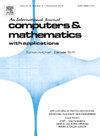MFPC-PIML: Physics-informed machine learning based on multiscale Fourier feature phase compensation
IF 2.5
2区 数学
Q1 MATHEMATICS, APPLIED
引用次数: 0
Abstract
The paradigm of physics-driven forward electromagnetic computation holds significance for enhancing the accuracy of network approximations while reducing the dependence on large-scale datasets. However, challenges arise during the training process when dealing with objective functions characterized by high-frequency and multi-scale features. These challenges frequently occur as difficulties in effectively minimizing loss or encountering conflicts among competing objectives. To overcome these obstacles, we carried out analysis leveraging the Neural Tangent Kernel (NTK) as our theoretical framework for analysis. Through this, we propose a novel architectural solution: a Multi-scale Fourier Feature Phase Compensation (MFPC) technology, according to Gaussian kernel mapping. This architecture leverages a Gaussian kernel to enhance the spectral representation of coordinate data, expanding the frequency domain coverage of Fourier feature mapping. Additionally, by compensating for phase loss inherent in conventional Fourier mapping, our approach effectively mitigates training difficulties, accelerates convergence, and significantly improves the model's accuracy in capturing high-frequency components. Our research comprises a range of challenging examples, including the high-frequency Poisson equation and the isotropic layered medium scattering model. Through these examples, we demonstrate the proficiency of our proposed method in accurately solving high-frequency, multi-scale Partial Differential Equation (PDE) equations. This highlights its potential not only in forward modeling but also in solving evolution and inverse problems.
MFPC-PIML:基于多尺度傅立叶特征相位补偿的物理信息机器学习
物理驱动的正演电磁计算范式对于提高网络逼近的精度,同时减少对大规模数据集的依赖具有重要意义。然而,在训练过程中,处理以高频和多尺度为特征的目标函数会带来挑战。这些挑战经常出现在有效地减少损失或遇到相互竞争的目标之间的冲突方面的困难。为了克服这些障碍,我们利用神经切线核(NTK)作为分析的理论框架进行了分析。在此基础上,提出了一种基于高斯核映射的多尺度傅立叶特征相位补偿(MFPC)技术。该体系结构利用高斯核来增强坐标数据的频谱表示,扩大傅里叶特征映射的频域覆盖范围。此外,通过补偿传统傅里叶映射中固有的相位损失,我们的方法有效地减轻了训练困难,加速了收敛,并显着提高了模型捕获高频分量的准确性。我们的研究包括一系列具有挑战性的例子,包括高频泊松方程和各向同性层状介质散射模型。通过这些例子,我们证明了我们提出的方法在精确求解高频、多尺度偏微分方程(PDE)方程方面的熟练程度。这突出了它的潜力,不仅在正演建模,而且在解决进化和逆问题。
本文章由计算机程序翻译,如有差异,请以英文原文为准。
求助全文
约1分钟内获得全文
求助全文
来源期刊

Computers & Mathematics with Applications
工程技术-计算机:跨学科应用
CiteScore
5.10
自引率
10.30%
发文量
396
审稿时长
9.9 weeks
期刊介绍:
Computers & Mathematics with Applications provides a medium of exchange for those engaged in fields contributing to building successful simulations for science and engineering using Partial Differential Equations (PDEs).
 求助内容:
求助内容: 应助结果提醒方式:
应助结果提醒方式:


